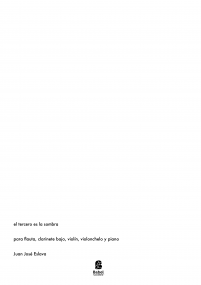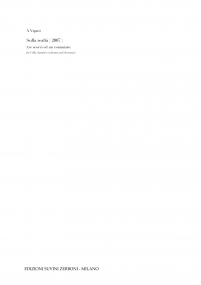Les Quatre Cents Farces du diable
For alto flute, bass clarinet, violin, cello, small percussion
(performed by the same musicians), video & electronics. About a film by Georges Méliès & a text by Pilar Martín Gila.
(performed by the same musicians), video & electronics. About a film by Georges Méliès & a text by Pilar Martín Gila.
12,00 €
Digital version (+0,00 €) instant download
Printed format (+16,20 € printing and shipping). Colissimo7-14 days aprox.
When you buy a score, you can contact the composer right here!
Specifications
Region
Europe
Estimated Duration
16 - 20min
Date
2022
ISMN : 979-0-2325-6740-2
Notes on this piece [ENG]
Starting a work around a silent film is a challenge that I had not known until now. Even more so when it comes to a filmmaker like Georges Méliès, a pioneer of this art and, moreover, an agglutinator of different aspects that make his works especially complex when it comes to working with them musically. One of these aspects that first came to my mind was the question about the speed of visual narration, how to deal with it from a contemporary musical discourse and how to work what could be observed in a humorous tone in which my music does not usually move. And the more concrete question would be this: do we see today that speed and overstimulated action as a humorous element or, in his time it was not like that, or perhaps it was not to the same extent? That issue remains up in the air; In this case, I have tried to leave this aspect in balance, without tilting towards an affirmative position at any time, but neither ignoring the narrative aspect of the cinematographic discourse, which would not have made much sense.
On the other hand, the presence of Pilar Martín Gila's text has led to the inclusion of a very special level in the musical work. Working with an image from the beginning of the 20th century is not the same if a current poetic text mediates between the film and the musical work, contributing all of its sound component (it must be taken into account that the text appears integrated into the electronics). That abyss of time is attenuated by what we perceive as related and close poetics, and this has given rise to a very interesting work. The text by Pilar Martín Gila, based on the contract that the devil makes with the engineer who is the protagonist of the film -represented in the text in the same figure as Méliès-, unfolds a poetic level that, from the sonorous and the musical, is approached very special and sometimes disturbing way.
Another aspect that could be highlighted is the relationship between the musical instruments and the electronics, which at all times has tried to be organic and nothing in contrast with the electronic part. The integration of acoustics has been an important aspect in the compositional development of the work. However, the use of small percussion instruments –played by the flute, clarinet, violin and cello players themselves- does intend to establish an estrangement with similar sounds in electronics, so that the listener may ask a question about the origin of the sound source.
[ESP]
Abordar una obra en torno a una película muda es un reto que no había conocido hasta ahora. Más cuando se trata de un cineasta como Georges Méliès, pionero de este arte y, además, aglutinador de diferentes aspectos que hacen sus obras especialmente complejas a la hora de trabajar musicalmente con ellas. Uno de estos aspectos que primero se me presentaron fue la pregunta sobre la velocidad de la narración visual, cómo afrontarla desde un discurso musical contemporáneo y cómo trabajar lo que se podría observar en un tono de humor en el que mi música no se suele mover. Y la pregunta más concreta sería esta: ¿vemos hoy esa velocidad y acción sobreestimulada como un elemento humorístico o, en su tiempo no era así, o quizá no lo era en la misma medida? Esa cuestión queda en el aire; en este caso, he intentado dejar en equilibrio este aspecto, sin bascular hacia una posición afirmativa en ningún momento, pero tampoco obviando el aspecto narrativo del discurso cinematográfico, lo que no hubiera tenido mucho sentido.
Por otro lado, la presencia del texto de Pilar Martín Gila ha supuesto en la obra musical la inclusión de un plano muy especial. Trabajar con una imagen de principios del siglo XX no es lo mismo si un texto poético actual media entre la película y la obra musical aportando todo su componente sonoro (hay que tener en cuenta que el texto aparece integrado en la electrónica). Ese abismo del tiempo queda atenuado por lo que percibimos como una poética afín y cercana, y esto ha dado lugar a un trabajo muy interesante. El texto de Pilar Martín Gila, fundamentado en el contrato que el diablo hace con el ingeniero protagonista del film –representado en el texto en la misma figura de Méliès-, despliega un estrato poético que, desde lo sonoro y lo musical, se aborda de manera muy especial y, en ocasiones, perturbadora.
Otro aspecto que podría resaltar es la relación de los instrumentos con la electrónica, que en todo momento ha pretendido ser orgánica y nada contrastante con esta última. La integración de lo acústico ha sido un aspecto importante en el desarrollo compositivo de la obra. Sin embargo, la utilización de pequeños instrumentos de percusión –tocados por los propios intérpretes de flauta, clarinete, violín y cello- sí pretende establecer un extrañamiento con sonidos similares en la electrónica, de manera que pueda surgir en el oyente una pregunta sobre el origen de la fuente sonora.
Add to a playlist
- Login to create your own lists
Starting a work around a silent film is a challenge that I had not known until now. Even more so when it comes to a filmmaker like Georges Méliès, a pioneer of this art and, moreover, an agglutinator of different aspects that make his works especially complex when it comes to working with them musically. One of these aspects that first came to my mind was the question about the speed of visual narration, how to deal with it from a contemporary musical discourse and how to work what could be observed in a humorous tone in which my music does not usually move. And the more concrete question would be this: do we see today that speed and overstimulated action as a humorous element or, in his time it was not like that, or perhaps it was not to the same extent? That issue remains up in the air; In this case, I have tried to leave this aspect in balance, without tilting towards an affirmative position at any time, but neither ignoring the narrative aspect of the cinematographic discourse, which would not have made much sense.
On the other hand, the presence of Pilar Martín Gila's text has led to the inclusion of a very special level in the musical work. Working with an image from the beginning of the 20th century is not the same if a current poetic text mediates between the film and the musical work, contributing all of its sound component (it must be taken into account that the text appears integrated into the electronics). That abyss of time is attenuated by what we perceive as related and close poetics, and this has given rise to a very interesting work. The text by Pilar Martín Gila, based on the contract that the devil makes with the engineer who is the protagonist of the film -represented in the text in the same figure as Méliès-, unfolds a poetic level that, from the sonorous and the musical, is approached very special and sometimes disturbing way.
Another aspect that could be highlighted is the relationship between the musical instruments and the electronics, which at all times has tried to be organic and nothing in contrast with the electronic part. The integration of acoustics has been an important aspect in the compositional development of the work. However, the use of small percussion instruments –played by the flute, clarinet, violin and cello players themselves- does intend to establish an estrangement with similar sounds in electronics, so that the listener may ask a question about the origin of the sound source.
[ESP]
Abordar una obra en torno a una película muda es un reto que no había conocido hasta ahora. Más cuando se trata de un cineasta como Georges Méliès, pionero de este arte y, además, aglutinador de diferentes aspectos que hacen sus obras especialmente complejas a la hora de trabajar musicalmente con ellas. Uno de estos aspectos que primero se me presentaron fue la pregunta sobre la velocidad de la narración visual, cómo afrontarla desde un discurso musical contemporáneo y cómo trabajar lo que se podría observar en un tono de humor en el que mi música no se suele mover. Y la pregunta más concreta sería esta: ¿vemos hoy esa velocidad y acción sobreestimulada como un elemento humorístico o, en su tiempo no era así, o quizá no lo era en la misma medida? Esa cuestión queda en el aire; en este caso, he intentado dejar en equilibrio este aspecto, sin bascular hacia una posición afirmativa en ningún momento, pero tampoco obviando el aspecto narrativo del discurso cinematográfico, lo que no hubiera tenido mucho sentido.
Por otro lado, la presencia del texto de Pilar Martín Gila ha supuesto en la obra musical la inclusión de un plano muy especial. Trabajar con una imagen de principios del siglo XX no es lo mismo si un texto poético actual media entre la película y la obra musical aportando todo su componente sonoro (hay que tener en cuenta que el texto aparece integrado en la electrónica). Ese abismo del tiempo queda atenuado por lo que percibimos como una poética afín y cercana, y esto ha dado lugar a un trabajo muy interesante. El texto de Pilar Martín Gila, fundamentado en el contrato que el diablo hace con el ingeniero protagonista del film –representado en el texto en la misma figura de Méliès-, despliega un estrato poético que, desde lo sonoro y lo musical, se aborda de manera muy especial y, en ocasiones, perturbadora.
Otro aspecto que podría resaltar es la relación de los instrumentos con la electrónica, que en todo momento ha pretendido ser orgánica y nada contrastante con esta última. La integración de lo acústico ha sido un aspecto importante en el desarrollo compositivo de la obra. Sin embargo, la utilización de pequeños instrumentos de percusión –tocados por los propios intérpretes de flauta, clarinete, violín y cello- sí pretende establecer un extrañamiento con sonidos similares en la electrónica, de manera que pueda surgir en el oyente una pregunta sobre el origen de la fuente sonora.
Instrumentation
Flute|Bass clarinet|Violin|Cello|Electronics|Video
Score Details
Format - A4 / US Letter
Pages - 76
Pages - 76








